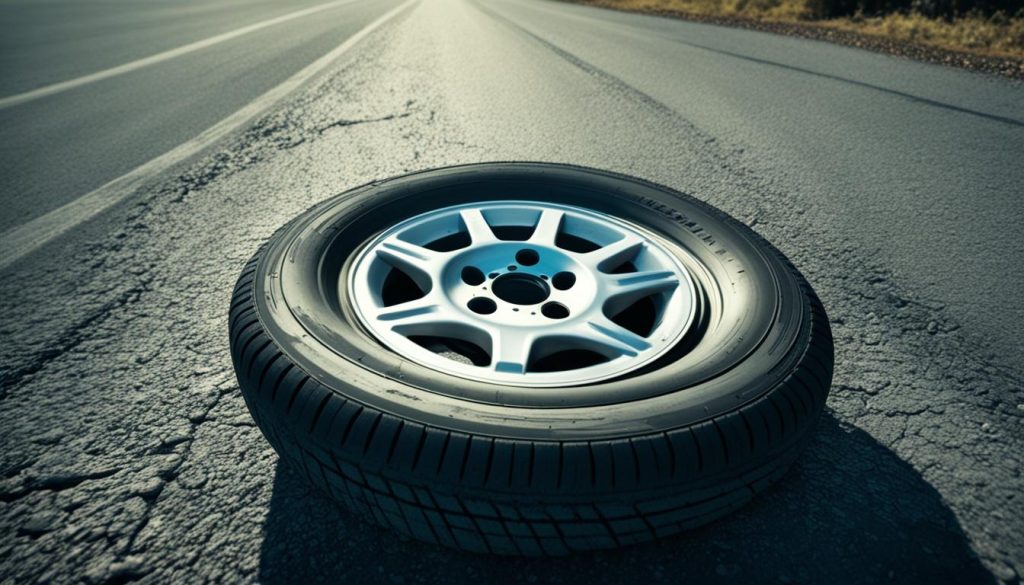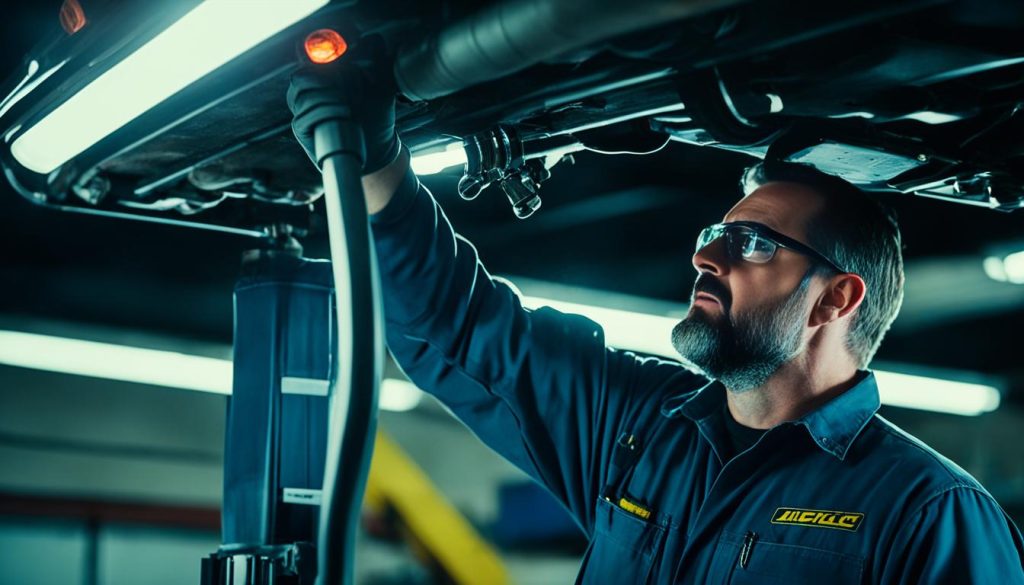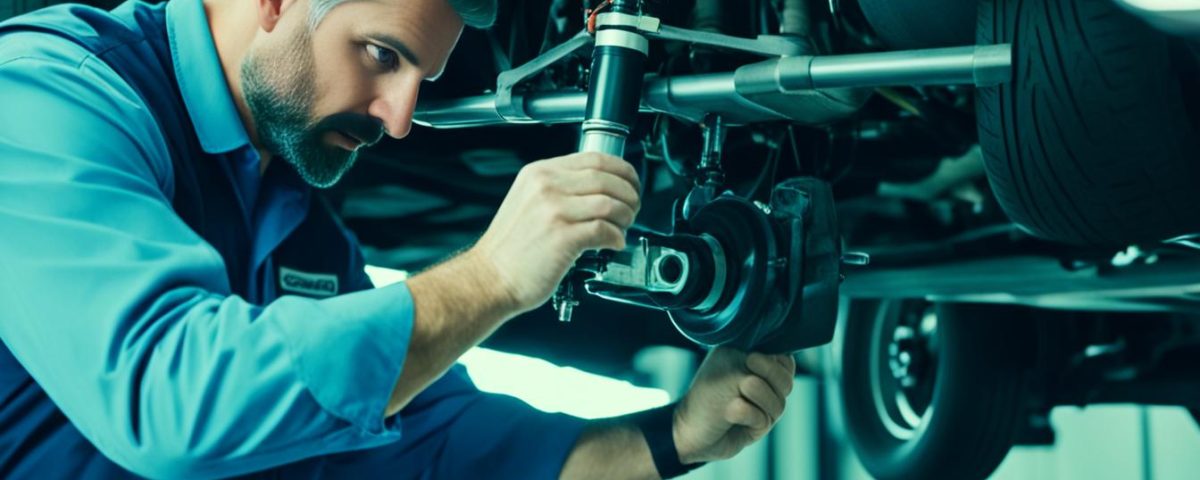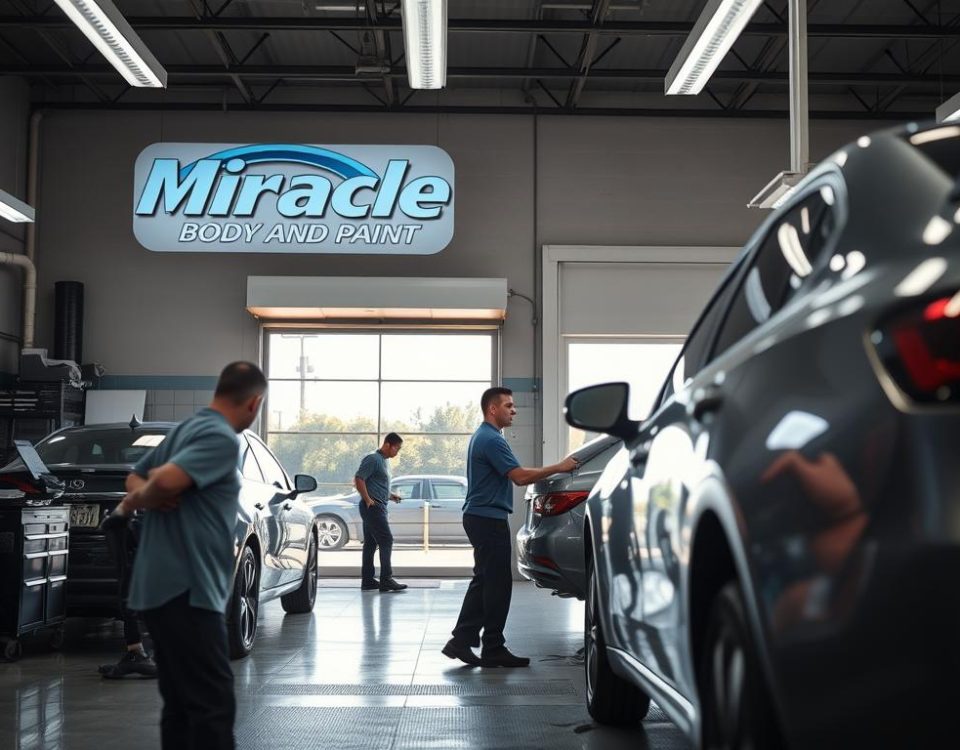
Top Road Safety Tips to Avoid Collisions

The Benefits of Choosing Collision Repair with a Lifetime Warranty
At the heart of a vehicle’s performance and handling lies the suspension system. This intricate network of components plays a crucial role in ensuring a smooth, safe, and comfortable ride. However, suspension damage can occur due to various factors, such as collisions, rough terrain, or general wear and tear. As responsible vehicle owners, it’s essential to understand how to identify and address suspension issues promptly to maintain the optimum performance of our cars.
Key Takeaways
- Understand the role and components of the vehicle’s suspension system
- Recognize common signs of suspension damage, such as uneven tire wear and excessive bouncing
- Learn the inspection techniques used by automotive technicians to diagnose suspension problems
- Discover the steps to diagnose suspension issues professionally and address them effectively
- Maintain your vehicle’s suspension to ensure a smooth, safe, and comfortable ride
Understanding the Role of Suspension System
The vehicle suspension system plays a crucial role in ensuring a smooth and comfortable ride. This complex system comprises various components, including the chassis, springs, shocks, and struts, all working together to support the vehicle’s weight, absorb impacts from the road, and maintain traction between the tires and the ground. Understanding the basics of the suspension system, as well as the differences between the front and rear suspension, is essential for diagnosing and addressing any issues that may arise.
Basics of the Suspension System
The suspension system is designed to provide a balance between ride comfort and handling. It absorbs the shocks and vibrations from the road, preventing them from being transmitted directly to the vehicle’s occupants. This helps to maintain the vehicle’s stability and control, even on rough or uneven surfaces.
Front Suspension
The front suspension is particularly important for steering and forward momentum, especially in front-wheel-drive vehicles. It typically consists of a combination of coil springs, shock absorbers, and control arms, which work together to keep the front wheels in proper alignment and ensure responsive handling.
Rear Suspension
The rear suspension, on the other hand, primarily manages traction and stability in rear-wheel-drive vehicles. It may include a variety of suspension components, such as leaf springs, coil springs, or a multi-link design, depending on the vehicle’s make and model. The rear suspension plays a crucial role in maintaining the vehicle’s balance and preventing unwanted movement during acceleration, braking, and cornering.
By understanding the basic functions and differences between the front and rear suspension systems, you can better identify and address any issues that may arise with the vehicle’s suspension components or the overall vehicle suspension system.
Suspension Damage Repair – Common Signs to Watch Out For
Identifying the early signs of suspension damage is crucial for maintaining your vehicle’s performance and safety. Two of the most common indicators of suspension issues are a vehicle pulling to one side and excessive bouncing or dipping.
Vehicle Pulling to One Side
If your vehicle starts to veer to the left or right while driving on a straight road, it could be a sign of suspension damage. This can be caused by a variety of factors, including misaligned wheels, worn-out ball joints, or uneven tire wear. Ignoring this issue can lead to further damage and compromise your vehicle’s handling and stability.
Excessive Bouncing and Dipping
Another telltale sign of suspension problems is excessive bouncing or dipping when driving over bumps or potholes. This is often a result of faulty shock absorbers or worn-out springs, which can no longer effectively absorb the impact of the road. Excessive bouncing can make your ride uncomfortable and can also affect your vehicle’s braking and steering performance.
Paying close attention to these warning signs and addressing any suspension issues promptly can help you maintain your vehicle’s handling, safety, and overall performance. Regular inspections by a qualified technician can also help identify and address any suspension problems before they become more serious.

Inspecting for Suspension Issues
Identifying and addressing suspension problems is a critical aspect of vehicle maintenance and safety. Professional collision repair technicians possess the specialized training and expertise required to thoroughly inspect a vehicle’s suspension system, pinpointing any issues that may compromise its performance and handling.
Visual Inspection by Technicians
During a visual inspection, technicians carefully examine various components of the suspension system, including the tires, wheel alignment, and the overall stance of the vehicle. This meticulous evaluation allows them to detect any signs of suspension damage, such as uneven tire wear, misaligned wheels, or unusual body positioning. By carefully assessing the vehicle’s physical condition, technicians can identify the root cause of the problem and develop an effective repair plan.
Test Drive and Alignment Checks
In addition to the visual inspection, technicians will conduct a test drive to assess the vehicle’s handling and responsiveness on the road. This real-world evaluation helps them identify any issues that may not be immediately apparent during a static inspection. Furthermore, alignment checks are performed to ensure the vehicle’s wheels are properly positioned, as improper alignment can significantly impact the suspension system’s performance and the overall driving experience.
By combining these comprehensive inspection techniques, collision repair technicians can accurately diagnose and address suspension issues, restoring the vehicle’s handling, safety, and overall performance.

Learning to Diagnose Suspension Problems Professionally
Becoming a skilled collision repair technician requires specialized training and hands-on experience in diagnosing and repairing suspension problems. Programs like the Collision Repair & Refinish Technology (CCRT) at Universal Technical Institute (UTI) provide students with the knowledge and practical skills to inspect, service, and replace suspension components using state-of-the-industry equipment.
By learning how to identify and address suspension issues, these technicians can play a crucial role in restoring vehicles to their optimal performance and safety after a collision. From diagnosing suspension problems to executing professional suspension repair, this specialized training equips students with the expertise needed to excel as collision repair technicians.
The curriculum covers a range of topics, including:
- Understanding the fundamentals of the suspension system, including the front and rear suspension components
- Identifying common signs of suspension damage, such as vehicle pulling and excessive bouncing
- Performing thorough inspections, including visual assessments and test drives
- Developing the skills to diagnose and troubleshoot suspension problems professionally
- Mastering the techniques to service, repair, and replace suspension parts
With this comprehensive training, graduates of the CCRT program at UTI are well-equipped to excel as collision repair technicians, skilled in diagnosing suspension issues and executing professional suspension repair services. Their expertise is invaluable in restoring vehicles to their pre-accident condition and ensuring the safety and performance of the suspension system.
Conclusion
In conclusion, recognizing and repairing suspension damage is a crucial aspect of collision repair. By understanding the role and components of the suspension system, we can be aware of common warning signs and know the inspection techniques used by professional technicians. This allows vehicle owners to take proactive steps to address suspension issues before they escalate.
Whether through DIY repairs or seeking the expertise of a qualified collision repair specialist, properly maintaining and restoring the suspension system is essential for ensuring a smooth, safe, and reliable driving experience. By following a comprehensive suspension repair guide, we can ensure our vehicles perform at their best and provide a comfortable, controlled ride for years to come.
The suspension repair conclusion is clear – attention to suspension health is vital for the overall performance and safety of any vehicle. By prioritizing suspension care, we can keep our cars, trucks, and SUVs operating at peak efficiency while enjoying a more comfortable and secure driving experience on the roads.



